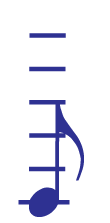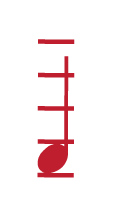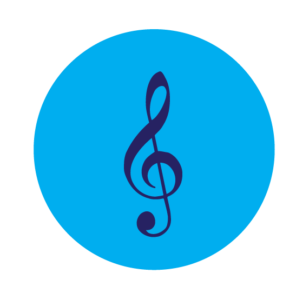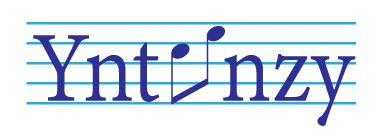Music is like a language with sounds, words, and writing. Everyone becomes more familiar with reading and writing music by playing games with Yntunzy cards. The writing of music or musical notation is a framework for symbolizing the pitch of a note (how high or low) and the length of the sound or duration. Musical notation allows the writing of a collection of sounds that can be played at once for a chord or over time for a piece of music such as a song or a concerto.
MUSIC & EDUCATION
INTRO TO MUSIC
MUSICAL NOTES
SCALES
NATURALS
# SHARPS #
♭ FLATS ♭
 Notes are symbols that indicate to play a sound for an amount time called the duration. The Yntunzy basic deck uses whole notes – hollow oval with the longest sound, half notes – hollow oval with a stem with a sound half as long as the whole note, quarter notes – filled oval with a stem played for one quarter as long as the whole note, and eighth notes – filled oval with a stem and one flag played for one eighth as long as the whole note. Each additional flag on a note cuts the time in half. A dot next to the oval of the note indicates to play the sound 1 and a half times as long so that a dotted half note is a three quarter note. There is an expander pack for sixteenth notes and three quarter (dotted half notes.)
Notes are symbols that indicate to play a sound for an amount time called the duration. The Yntunzy basic deck uses whole notes – hollow oval with the longest sound, half notes – hollow oval with a stem with a sound half as long as the whole note, quarter notes – filled oval with a stem played for one quarter as long as the whole note, and eighth notes – filled oval with a stem and one flag played for one eighth as long as the whole note. Each additional flag on a note cuts the time in half. A dot next to the oval of the note indicates to play the sound 1 and a half times as long so that a dotted half note is a three quarter note. There is an expander pack for sixteenth notes and three quarter (dotted half notes.)
Note Names
Where the oval or head of the note is on the staff of five (with the ability to extend for higher or lower notes) parallel lines determines the note – how high or how low. referred to using the letters A, B, C, D, E, F, G for the natural notes. Because sound is about vibration and frequency of waves, only the first seven letters of the alphabet are used and then you start with A again for the next “octave.” We say that notes with the same name are an octave apart. Between the notes named by the letters are the sharp (A♯) – half-step higher – notes and flats (B♭) – half-step lower notes. A chromatic scale with all the notes in the span of an octave, there would be: C, C♯, D, D♯, E, F, F♯, G, G♯, A, A♯, B. Certain notes can be identified as flat or sharp: A♯ = B♭, C♯ = D♭, D♯ = E♭, F♯ = G♭, G♯ = A♭. There is a bit more explanation of this in Clefs and Keys. The basic Yntunzy deck does not have sharps or flats. There are expander packs for sharps and flats for all suits.




Clef and Keys
G or treble clef is the most common. It is part of the writing that defines the  notes on the staff. Yntunzy primarily uses the treble clef with an expander pack for the F or bass clef (
notes on the staff. Yntunzy primarily uses the treble clef with an expander pack for the F or bass clef ( ![]() ) where the notes are lower. F clef is used to write music for bass voices and lower instruments.
) where the notes are lower. F clef is used to write music for bass voices and lower instruments.
Music refers to the “key” of a scale based on the chosen low note and how many notes are sharp or flat in the scale. Music compositions traditionally start with a key that tells what notes are assumed to be natural, sharp or flat in the piece unless otherwise indicated. The key can have a significant effect on the mood of a piece.
Yntunzy starts with a scale in C-major which is the notes C-D-E-F-G-A-B-C. All the intervals and chords in the basic deck use these notes. You can get an expander pack of sharps and flats to swap cards and play in the keys of F (1 flat), B♭ (2 flats), E♭ (3 flats), A♭ (4 flats), D♭ (5 flats), G (1 sharp), D (2 sharps), A (3 sharps), E (4 sharps), B (5 sharps.) All the games can be played the same way in any key. Instructions for adapting the deck are included in the expander pack.
Intervals and chords:
Because of the nature of sound, when two notes are played at the same time, it can create different qualities of sound. In musical language, people have given names to the distance between two notes (such as A – C# or D – F, etc) called intervals. The names of the intervals are:
Chords consist of playing more than two notes at a time, generally three or four. Certain combinations of notes are given names based on the lowest note of the combination and the intervals between the notes. Other note combinations can be played however they are not considered part of the “standard” chords. The chords are indicated on the jokers that come with the Yntunzy cards.
Here are the chords that are used for games with the basic deck of Yntunzy cards:
| Triads (three-notes) | Four note chords |
| C major – C – E – G | C major seventh – C – E – G – B |
| D minor – D – F – A | D minor seventh – D – F – A – C |
| E minor – E – G – B | E minor seventh – E – G – B – D |
| F major – F – A – C | F major seventh – F – A – C – E |
| G major – G – B – D | G dominant seventh – G – B – D – F |
| A minor – A – C – E | A minor seventh – A – C – E – G |
| B diminished – B – D – F | B minor seventh flat five – B – D – F – A |
The Yntunzy cards expander pack with sharps and flats provides cards to play in 10 additional keys. The keys and the chords for those keys are provided on the jokers that come with the expansion pack.
Here are some websites that provide more information about intervals and chords:
https://www.musictheory.net/calculators/interval
https://www.scales-chords.com/chord-namer/?notes=C%23;D%23;F%23;A%23&key=&bass=D%23
EDUCATION
Yntunzy In The Classroom
Trying to teach music to anyone from the ages of five to fifty-five?
Yntunzy cards and apps are perfect for classroom use to help students learn music notation in a fun way. The apps also help support ear training (specially designed ear-training apps coming soon). How can playing cards help students learn music?
When your students play games such as Rummy or Solitaire, they learn the language of music as they become fluent with note names and familiar with music notation. They also learn about the progression of notes and the relationships of notes in octaves, intervals, and chords.
Yntunzy cards with customized backs are a great gift for supporters, parents and students.
Yntunzy wants to support music education at all levels of education so contact us for information about discounts for educational institutions.
